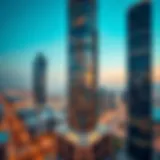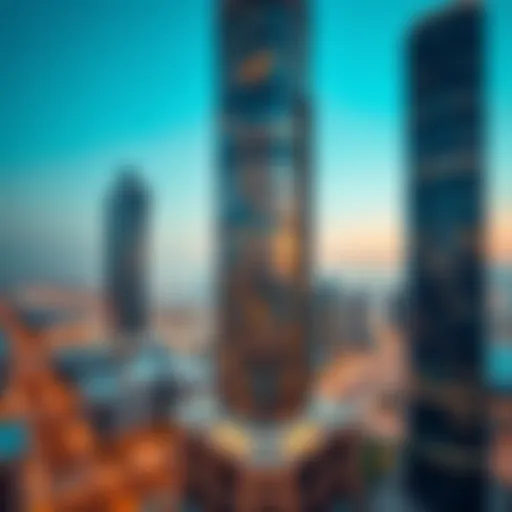Exploring the Architectural Significance of the Bin Kalaib Building


Intro
The Bin Kalaib building stands as a notable example of modern architecture nestled in the ever-evolving landscape of Dubai. This structure is more than just a collection of bricks and beams; it conveys the history and ambition of a city that's constantly in flux. The building's unique design reflects not only aesthetic considerations but also the dynamic nature of real estate in Dubai, entwining its roots with the local culture and urban development.
In the following sections, we will explore market trends related to the Bin Kalaib building, delving into current conditions and future projections, as well as outlining potential investment opportunities that come with this landmark. Whether you are an investor looking for the next big opportunity or a homebuyer searching for the ideal location, understanding the role of the Bin Kalaib building in the broader context of Dubai's real estate market is essential.
Prelims to the Bin Kalaib Building
The Bin Kalaib Building stands as a key landmark in Dubai's bustling skyline, embodying the city's rapid transformation and offering insights into the architectural trends shaping the region. With its unique design and strategic location, this building is not just a structure; it serves as a microcosm of Dubai's evolving landscape, particularly in the realm of real estate.
Understanding the significance of the Bin Kalaib Building requires diving into its multifaceted identity. It's a place where history and modernity coexist, appealing to a diverse set of stakeholders, including investors, homebuyers, and urban developers.
Importance of the Bin Kalaib Building
- Cultural Reflection: The building highlights the aspirations of Dubai, showcasing cultural motifs while standing tall amid the state's modernity. Observing its structure and surrounding environment gives one deep insights into the local heritage and future ambitions.
- Investment Opportunities: As a landmark, the building attracts investors looking for profitable ventures in Dubai's property market. Due to its design and location, it holds promise for increasing property values and rental yields, thus offering significant returns on investment.
- Community Hub: The Bin Kalaib Building acts as a vital element in the neighborhood, facilitating local engagement and community activities. Its design invites interaction, making it a potential setting for events that foster community spirit.
Exploring the nuances associated with the Bin Kalaib Building thus paves the way for a broader understanding of Dubai’s architectural identity and its implications for real estate stakeholders. With each stone and detail, the building narrates a story, inviting homebuyers, agents, and analysts to delve deeper into the rich tapestry of urban life around it.
Historical Background
The historical background of the Bin Kalaib building is critical to understanding its significance within the urban fabric of Dubai. This section delves into the origins and evolution of the structure, shedding light on its initial purpose and how it has metamorphosed over time, reflecting both societal changes and advancements in architectural design. Recognizing the past is key for investors and homebuyers, as the history conveys not just a story, but potential value and opportunities that resonate with different generations.
Founding and Initial Purpose
The Bin Kalaib building was established during a period of rapid development in Dubai, where the city began its transformation from a trading port into a global economic hub. Originally designed to serve as a mixed-use complex, its first blueprint combined both residential and commercial spaces catering to exhibitors and merchants. This approach was indicative of the burgeoning economic landscape of Dubai, where trade and commerce began to flourish.
The initial purpose successfully attracted mid-tier businesses and families alike, ensuring a vibrancy that was essential to the community. It became a melting pot of cultures, with diverse businesses and communities coexisting within its walls. The planning phase emphasized practicality, practicality that still resonates through the building today, allowing for a diverse utilization of space.
Architectural Evolution
Over the decades, the Bin Kalaib building has undergone several renovations and expansions, allowing it to maintain its relevance in a city that’s renowned for its constantly evolving skyline. The evolution of its architecture is a reflection of significant changes in both construction technologies and local aesthetic preferences. Initially exhibiting a purely functional style, the building's facade began to incorporate elements of Islamic architecture, with intricate geometric patterns and ornamental motifs that echo Dubai's rich cultural heritage.
In recent years, elements of contemporary design have been added. Glass facades and aluminum finishes now blend seamlessly with traditional materials, fostering a dialogue between the old and the new. This architectural transformation is not merely cosmetic; it demonstrates a willingness to adapt to modern needs, while retaining a connection to its roots. As developers and investors analyze property potential, this evolution stands as a testament to the building’s versatility and durability in an ever-changing marketplace.
Key Design Features
- Use of sustainable materials in renovations
- Blending of traditional and modern architectural styles
- Innovations in space utilization, making it adaptable for various functions
Impact on Local Culture
The impact of the Bin Kalaib building on local culture cannot be overstated. It has served as a community nexus, a place where various social and cultural events unfold, enriching the local event calendar. Festivals, art exhibitions, and trade shows held in and around the Bin Kalaib have engaged the community, fostering local traditions and allowing a platform for artistic expression.
Furthermore, the building has contributed to the sense of identity for its residents and workers; it stands as a symbol of modernity within a traditionally rich context. Each brick and corner carries the aspirations of the many who have walked through it over the years.
Architectural Characteristics
The architectural characteristics of the Bin Kalaib Building not only define its aesthetic appeal but also ground it firmly within the context of Dubai's rich architectural tapestry. Understanding these characteristics is essential for appreciating how this building interacts with its surroundings and serves the community. This section will delve into various elements—ranging from design influences to structural innovations and interior design features—shedding light on how they contribute to the building's significance in today's real estate landscape.
Design Influence
Contemporary Styles
Contemporary styles in architecture are often characterized by clean lines, open spaces, and a focus on functionality. In the case of the Bin Kalaib Building, these elements play a critical role in attracting a modern demographic. The contemporary aesthetic allows for a flexible usage of space, which can accommodate both commercial and residential needs seamlessly.
A key characteristic of this style is minimalism—less is often more. The focus remains on creating a conducive environment for productivity and creativity. This is particularly advantageous in today’s market, where both businesses and individuals seek flexibility and adaptability.


One unique feature of contemporary styles seen in Bin Kalaib is the large glass facades that promote natural light and offer a connection to the outside environment. This can enhance the occupant experience, making it feel less confined. However, it is essential to consider the thermal implications of extensive glazing, which might increase energy costs during the hot Dubai summers.
Traditional Emphasis
On the flip side, traditional emphasis in architecture often draws from local historical elements and cultural motifs, creating a rich narrative woven into the fabric of the building. This aspect of the Bin Kalaib Building pays homage to the heritage of Dubai, integrating cultural references that resonate with the community. The use of locally inspired tile work and architectural forms reflects a deep appreciation for tradition while still providing modern conveniences.
A notable characteristic of this approach is its ability to foster community identity. By incorporating traditional design elements, the Bin Kalaib Building becomes more than just a structure; it turns into a landmark that evokes local pride. The unique feature of traditional emphasis here involves the intricate designs that adorn visible areas, offering both an aesthetic appeal and a conversation starter among visitors.
Yet, traditional styles can sometimes clash with contemporary tastes. Balancing the two can be a challenge, as some modern occupants might find traditional features dated. However, it’s this very mix that makes the Bin Kalaib Building intriguing and relevant in a city known for its rapid modernization.
Structural Innovations
Materials Used
The choice of materials is crucial in determining not only the durability and aesthetics of a building but also its overall sustainability. The Bin Kalaib Building utilizes high-quality composite materials that ensure structural integrity while also being lightweight. This contributes positively to the overall performance of the building, particularly when it comes to seismic considerations, an essential aspect in this earthquake-prone region.
A key characteristic here is the recyclability of materials, which complements Dubai's push for sustainability in construction. Sustainable materials ensure that the building is responsive to the environmental challenges of the region. One unique feature is the use of insulated concrete forms, which enhance energy efficiency while providing excellent sound insulation—vital for a bustling urban environment.
However, the reliance on advanced materials can escalate construction costs, posing a financial challenge for developers. Yet, the long-term benefits often outweigh these initial expenditures by ensuring lower maintenance and greater energy efficiency throughout the building's life.
Construction Techniques
The construction techniques employed in the Bin Kalaib Building are a testament to innovation and precision. Utilizing advanced techniques such as modular construction not only speeds up the building process but also minimizes waste—an increasing concern in modern construction.
A key characteristic of these techniques is their ability to streamline operations while ensuring quality control. By creating components in a controlled environment, builders can tackle discrepancies before they reach the site, lending to a higher quality build overall.
A unique feature of the construction technique at Bin Kalaib is the incorporation of smart technology throughout the process, allowing for real-time monitoring and adjustments. While technology can sometimes introduce complexity, the end result is a structure that is robust and designed to handle future enhancements seamlessly.
Another consideration to keep in mind is the timeline; while innovative techniques can cut down on headaches, they may require additional training and adjustments for the labor force, slowing down the initial pace in the transitional phase.
Interior Design Features
Spatial Layout
The spatial layout of the Bin Kalaib Building is distinguished by its open, airy design, fostering both collaboration and privacy where it's needed. With a keen focus on maximizing usable space without sacrificing comfort or style, this layout is particularly appealing both for residents and businesses alike.
A prime characteristic of this arrangement is its versatility. The interior can easily adapt to different purposes, whether it be a cozy residence or a bustling office environment. This adaptability makes Bin Kalaib an attractive option in the competitive Dubai real estate market.
The unique feature of this spatial layout lies in the open-plan areas which promote social interaction. Open spaces are conducive to creative collaboration, yet should always factor in the need for private areas. The tricky part here is creating the right configuration to maintain this balance while allowing for functional movement throughout different spaces.
Decorative Elements
Decorative elements incorporate not just the aesthetics but also the sense of identity within the Bin Kalaib Building. These features are often inspired by local crafts and materials, creating a beautiful juxtaposition between modernity and tradition.
A key characteristic of decorative elements is their ability to tell a story. From locally inspired artwork to custom light fixtures that reflect the heritage of the surrounding area, these elements weave an immersive narrative that resonates with both residents and visitors.
One unique aspect of these decorative elements is the integration of smart lighting solutions which not only bring aesthetics but also functionality. However, there can also be a risk of over-decorating spaces, potentially distracting from the simplicity and elegance of contemporary design.
In sum, the architectural characteristics of the Bin Kalaib Building offer a rich tableau that appeals to a range of audiences—from individual investors seeking a new home to savvy developers looking for the next big opportunity in Dubai's real estate market. Understanding each of these facets is essential for discerning the full impact of this building within its urban environment.
Current Usage and Functionality
The Bin Kalaib building’s relevance extends beyond its architectural grandeur. It serves as a microcosm of the interplay between residential and commercial uses in a rapidly changing urban setting. Evaluating its current state provides insights into how historical structures can adapt to the demands of modern life while still retaining their cultural significance.
Residential vs. Commercial Space
The Bin Kalaib building strikes a balancing act between residential and commercial spaces, weaving them together into a cohesive unit. Each section offers unique benefits; residential spaces attract families seeking community and lifestyle, while commercial areas draw businesses looking for prime real estate.


In many instances, the residential aspect serves as a comfortable dwelling for individuals and families, providing a sense of belonging right in the heart of the bustling city. The proximity to amenities, parks, and cultural sites boosts its residential appeal. However, the commercial side enhances the neighborhood's economic vitality, with shops and offices contributing to a vibrant street life. As such, the question arises: how can the space be optimized to serve both? Finding this equilibrium is essential, especially in a city that's always moving forward.
Economic Contributions
Job Creation
The Job Creation potential within the Bin Kalaib building has noteworthy implications. Not only does it generate employment opportunities, but it also revitalizes the local market ecosystem. When businesses rent space, they typically hire staff to manage operational needs. This creates a vacuum effect as service jobs spring up to support the influx of visitor traffic.
Moreover, job creation fosters a sense of community among the residents. People who work in nearby businesses often develop social ties, enriching the area's cultural fabric. However, it does come with a downside: job competition can lead to wage suppression if the labor market is oversaturated.
Local Business Impact
The Local Business Impact of the Bin Kalaib building is another vital aspect worth discussing. The presence of various companies supports entrepreneurs by providing them with access to clientele. As those who work or live in the area frequent local shops, demand rises. More foot traffic translates into higher sales and, potentially, business expansion.
However, it is crucial to note that the success of local businesses can sometimes lead to gentrification, displacing long-term residents or smaller operations that cannot keep up with the rising costs. Striking a balance between nurturing local businesses and allowing for growth can make all the difference.
Community Engagement
Events Hosted
Community engagement at the Bin Kalaib building often manifests through the events hosted within its walls or nearby spaces. These gatherings can range from art shows and food festivals to local fairs or workshops. By hosting events, the building promotes cultural expression. In addition, it helps neighbors connect, making the area feel more like home.
The popularity of such events often draws visitors from outside the immediate vicinity, further enriching the community experience, although this can occasionally lead to overcrowding, posing logistical challenges.
Public Perception
The Public Perception of the Bin Kalaib is multifaceted. How people view the building can have significant implications for real estate trends and investment opportunities in the area. If the community perceives the Bin Kalaib building as a local landmark worth preserving, it gains respect and becomes an emblem of neighborhood pride.
On the flip side, negative public sentiment could arise if locals feel that the building leans more towards commercialization rather than remaining true to its roots. Understanding and addressing these perceptions can thus be vital for its successful integration into the city's future.
Future Development Prospects
The future development prospects of the Bin Kalaib Building present a vast landscape of opportunities worth exploring. As a structure embedded within Dubai's vibrant real estate scene, its potential for growth, investment, and urban innovation is quite significant. With the area undergoing continuous transformation, the following aspects highlight why investors and developers need to pay close attention.
Urban Renewal Projects
Urban renewal is becoming a pivotal theme in Dubai's development narrative. The Bin Kalaib Building stands amid a wave of renewal efforts aimed at revitalizing older neighborhoods while merging modernity with tradition.
For instance, the surrounding area is ripe for upgrades, drawing in both local and international investment. The government often partners with private developers to breathe new life into such projects, creating spaces that attract footfall and enhance community engagement.
- Public Spaces: Enrichment of public spaces fosters a community, inviting residents to explore.
- Cultural Integration: Urban renewal allows for local culture and history to shine, connecting past and future.
- Infrastructure Improvements: New transport links and services tend to bolster property values, making it appealing for stakeholders.
"In Dubai, urban renewal not only shapes physical spaces but also genuine community bonds, combining heritage with modern living."
Investment Opportunities
Investment opportunities surrounding the Bin Kalaib Building are plentiful and deserving of attention. With Dubai's economy on an upward trajectory, strategic decisions today can yield considerable returns tomorrow. Factors influencing these opportunities include:
- Market trends: The real estate market in Dubai is experiencing fluctuations that astute investors can leverage.
- Location and Accessibility: Positioned well, the building allows for easy access to major commercial hubs—ideal for both residential and commercial purposes.
- Government Incentives: Knowing the local laws and available incentives for new developments can profoundly affect the financial bottom line.
Investors should consider diving into these opportunities not just for financial gain but to be part of a larger story of growth and progress in the region. Whether aiming to acquire a stake in the building or looking to support community-driven projects, the potential here beckons, presenting a win-win situation for all stakeholders involved.
By focusing on these future development prospects, interested parties can glean significant insights into the transformative potential linked to the Bin Kalaib Building.
Environmental Considerations


Understanding the Environmental Considerations surrounding the Bin Kalaib Building is key, especially given the increasing focus on sustainability in today’s urban environments. Dubai, known for its rapid development and luxurious lifestyle, faces unique challenges when it comes to balancing growth with environmental responsibility. The Bin Kalaib Building stands as a testament to these efforts, showcasing how architecture can harmonize with ecological priorities.
Sustainability Initiatives
The Bin Kalaib Building has embraced various sustainability initiatives that enhance its role within Dubai’s green architecture framework. One pivotal approach has been the use of eco-friendly construction materials. The deployment of sustainable materials not only reduces environmental impact during the building's lifecycle but also minimizes the carbon footprint. By sourcing locally, the building supports regional businesses while keeping transport emissions low.
Moreover, effective waste management practices have been integrated into the operation of the building. This includes recycling the majority of construction waste, which significantly lessens landfill contributions. Additionally, the design incorporates green roofs and terraces that promote biodiversity and help regulate building temperature, reflecting a commitment to the environment.
"Sustainable buildings like Bin Kalaib are not just structures; they are active participants in their ecological frameworks."
Integration of water conservation systems further underscores the emphasis on sustainability. Rainwater harvesting systems and efficient plumbing fixtures have been installed to reduce overall water usage, showcasing the importance of resource management in modern architecture. A significant part of these initiatives is also educational; residents and businesses are encouraged to engage in sustainable practices, thus amplifying the impact across the community.
Energy Efficiency
Energy efficiency is another critical aspect that the Bin Kalaib Building addresses thoroughly. By utilizing state-of-the-art technology and materials, the building significantly reduces its energy consumption compared to similar structures. Thermal insulation not only enhances occupant comfort but also minimizes reliance on heating and cooling systems.
The structure features smart energy management systems that monitor and adjust energy usage automatically. Sensors control lighting and climate conditions, ensuring that energy is used efficiently and sparingly. Furthermore, the inclusion of solar panels provides a clean, renewable energy source, further bolstering the building's eco-friendly credentials.
In summary, the Bin Kalaib Building demonstrates that architectural design can facilitate a synergy between urban development and environmental stewardship. Its sustainability initiatives and energy efficiency measures serve as a model for future projects aiming to meet the ecological needs of urban areas while ensuring economic viability for investors and residents alike.
Comparative Analysis with Similar Structures
When considering the Bin Kalaib building, a comparative analysis with similar structures provides significant insights that can guide investors, homebuyers, and developers alike in understanding its potential value. By examining both local and international examples, one can appreciate not merely the aesthetic and functional traits of the Bin Kalaib but also its standing in a wider context of architectural significance. This analysis reveals trends in design, functionality, and cultural resonance that may either enhance or detract from its market appeal.
Benchmarking with Leading Developments
In today's competitive real estate landscape, benchmarking against leading developments offers a thorough understanding of market positioning. The Bin Kalaib can be compared with other prominent buildings such as the Burj Khalifa and Dubai Marina Towers, both known for their architectural prowess and economic contributions.
For instance, the Bin Kalaib building stands out with its focus on sustainable materials and energy-efficient technologies, much like what is seen in the One Central development. This sustainability angle resonates well with eco-conscious investors, emphasizing the shifting priorities in property investments. Some key points of comparison include:
- Architectural Design: While the Burj Khalifa boasts unparalleled height and innovative design, the Bin Kalaib focuses on blending traditional elements with modern functionality, creating a unique appeal for certain demographic segments.
- Market Functionality: Unlike Dubai Marina Towers, designed primarily for luxury living, the Bin Kalaib accommodates both commercial and residential needs, thereby diversifying its marketability.
- Cultural Significance: The Bin Kalaib strives to reflect the local culture through architectural motifs, setting it apart from structures that prioritize international styles over regional heritage.
Lessons Learned
Comparing the Bin Kalaib with other buildings sparks essential lessons that can drive future architectural and investment decisions. The analysis reveals certain attributes that consistently contribute to successful property development:
- Adaptability: Buildings that evolve with changing market demands, just as Bin Kalaib has shown, tend to perform better over time.
- Community Integration: Projects like the Bin Kalaib demonstrate the importance of aligning with the community's cultural values to foster local loyalty, unlike some high-profile developments that remain disconnected from surrounding areas.
- Sustainability Practices: Learning from similar projects, the incorporation of green technologies not only grabs attention but also attracts a more environmentally aware clientele.
"Understanding the gaps and opportunities highlighted through comparative analysis can significantly shape the trajectory of a property’s market presence."
In summary, a thorough comparative analysis enriches the understanding of the Bin Kalaib building, providing a lens through which to evaluate its strengths and weaknesses against its peers. Identifying both successful strategies and pitfalls allows for a more informed approach towards investment and development.
Finale and Final Thoughts
As we draw this exploration to a close, the significance of the Bin Kalaib Building emerges clearly—not just as a part of Dubai's skyline, but as a critical node in its urban fabric. This structure stands as a testament to the city’s architectural ambition and economic vitality.
When considering the Bin Kalaib in the context of investment, it's important to recognize its strategic location and the growing demand for premium residential and commercial spaces in Dubai. The building offers prospective buyers and investors an opportunity to capitalize on a dynamic property market. Its blend of modern and traditional design offers not just aesthetic appeal, but also hints at the historical richness of the area, making any potential investment both a financial asset and a piece of cultural heritage.
Furthermore, the community engagement the building fosters through various hosted events and activities cannot be overlooked. It acts as a meeting point for local residents and visitors alike. This communal aspect enhances its value, as properties that cultivate a sense of belonging often appreciate better in the long run.
In contemplating the future, developers and analysts alike should pay close attention to how urban renewal projects intertwine with structures like the Bin Kalaib. Emerging sustainability practices may shift the paradigm for what is considered a desirable space in the coming years. Therefore, understanding the building's evolution and community role can yield meaningful insights into future market trends.
Ultimately, the Bin Kalaib Building is more than just another development in Dubai; it embodies opportunities for growth, cultural resonance, and a vision for sustainable urban living. For any investor, homebuyer, or urban planner, this landmark invites consideration and engagement.
Key Takeaways
- Architectural Significance: The building represents a sophisticated blend of modernity and tradition, reflecting Dubai's architectural evolution.
- Investment Potential: Its location and features position it as a desirable asset in the booming property market, providing clear opportunities for growth.
- Cultural Engagement: The Bin Kalaib is not merely a space but a hub for community activities, elevating its relevance beyond just bricks and mortar.
The Bin Kalaib Building's Legacy
The legacy of the Bin Kalaib Building will likely unfold over decades, with its influence extending into future developments in Dubai. As urban landscapes evolve, the principles embodied by this building can serve as an inspiration for new architectural endeavors. It holds the potential to become a reference point in discussions about city planning and cultural integration.
As these stories intertwine with the lives of residents, visitors, and investors, the Bin Kalaib Building ensures that it will be part of a dialogue about what the city represents and what it aspires to be in the face of rapid change.















